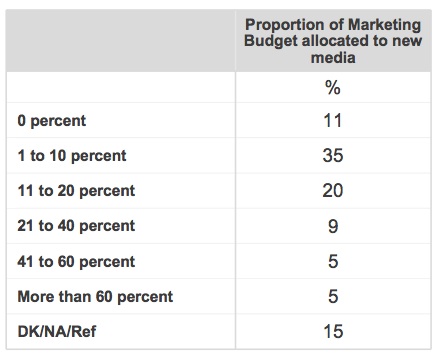TAPA Stats Report: the good, the bad, and the ugly
Chart above from the 2009 TAPA stats report shows “Use of New Media and Social Networking Media Among TAPA Members”
by Lindsay Schwietz
The Toronto Alliance for the Performing Arts (TAPA) announced their findings for their TAPA Stats Report Phase Two on Monday September 21st at City Hall. After examining data from the 92 performing arts companies who filled out their extensive online questionnaire, TAPA is optimistic about the results and the future of performing arts in Toronto.
THE GOOD
- Single ticket sales are up with 2.4 million tickets sold in 2007/2008.
- Theatre for Young Audiences is growing, with more than 90,000 kids being reached through performance in the 2007/08 season.
- The number of theatre productions has increased – 1,140 occurring in 2007/08, compared to 762 productions in 2004/05.
- An increase in subscriptions – close to 13,000 more paid subscribers since 2004/05.
- 78% of TAPA members surveyed are optimistic about the future.
THE BAD
- Only 28% of the theatres surveyed sell subscriptions to their season –the bulk of the increase is from the larger companies who do have subscriptions. Indie theatre is not booming.
- Although 95% of those surveyed have a website, 79% of them have no idea the statistics of who is using their website. Only 37% of them have online ticketing.
THE UGLY
- Part-time non-artistic personnel are down 13% from 2005/2006 statistics. Although theatres are potentially relying more on volunteers, that doesn’t bode well for the next generation trying to get work in a theatre office or their foot in the door of an organization.
- The total number of artistic and non-artistic jobs is down 1625 from 2005/06.
The most troubling set of statistics is that the total number of performances increased over a period where the total number of staff plummeted. These numbers will be helpful to convince politicians and funders of the immense contribution performing arts make to Toronto’s economy, but they aren’t indicative of particularly good circumstances for staff working on the front lines or those hoping to break into the industry.
You can read the complete report from the TAPA website by clicking here.



That is troubling. The implications of relying on predominantly volunteer staffing is staggering.
As for that social media number, does that include staff time in the budget numbers? Because it seems like a lot of us are putting in a lot of time but not converting it to dollars on a budgeting level.
Yeah, I don’t but the “volunteers are doing the work instead” theory for a second. The energy required to recruit, train, and retain a suitable volunteer is often greater than the return in labour. It’s a worthwhile practice to integrate a theatre or a company with a community, but not really as a staffing solution. I think these numbers mean 2 things:
1 More non-artistic staff are doing more work for the same money.
2 More artistic staff are doing more non-artistic work.
Very good question about whether staff time is incorporated in the social media #s MK. I have no idea. Either way I’d like to talk about those numbers in two years when print media is in full on “no one is reading me” crisis mode. One 1/4 of the companies fall into the 0%/don’t know category. By then those companies will at least be aware they have missed the boat.